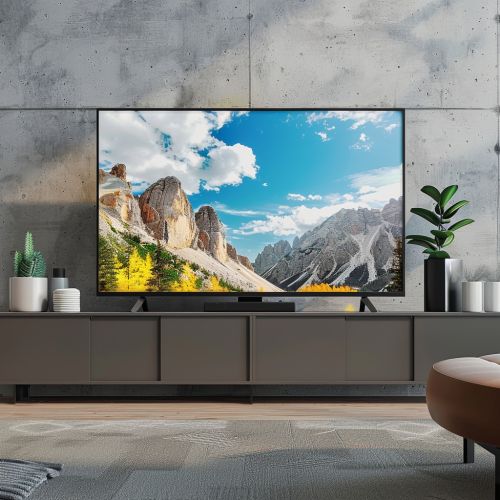Television set
Introduction
A television set, commonly referred to as a TV, is an electronic device that receives and displays audiovisual signals. It is a central component of modern entertainment systems, providing access to broadcast, cable, satellite, and streaming content. The development of television technology has evolved significantly since its inception, incorporating advancements in display technology, signal processing, and user interface design.
Historical Development
Early Innovations
The concept of television began in the late 19th and early 20th centuries with the invention of the cathode ray tube (CRT) and the mechanical scanning disk. The first practical demonstration of television was conducted by John Logie Baird in 1925, using a mechanical system. However, it was the development of electronic television by Philo Farnsworth and Vladimir Zworykin in the 1920s and 1930s that laid the foundation for modern television technology.
Post-War Expansion
After World War II, television technology rapidly advanced, and the medium became widely adopted in households. The 1950s saw the introduction of color television, with the National Television System Committee (NTSC) standard being adopted in the United States. This period also marked the beginning of mass production of television sets, making them more affordable and accessible to the general public.


Transition to Digital
The late 20th and early 21st centuries witnessed a significant shift from analog to digital television. Digital television (DTV) offers improved picture and sound quality, as well as the ability to transmit multiple channels within the same bandwidth. The transition to digital broadcasting was completed in many countries by the early 2010s, leading to the widespread adoption of high-definition television (HDTV) and later, ultra-high-definition television (UHDTV).
Technical Specifications
Display Technologies
Television sets have utilized various display technologies over the years:
- Cathode Ray Tube (CRT): The earliest form of television display, CRT technology uses electron beams to illuminate phosphors on the screen. While bulky and heavy, CRTs were known for their excellent color reproduction and contrast ratios.
- Liquid Crystal Display (LCD): LCD technology uses liquid crystals and a backlight to produce images. It became the dominant display technology in the early 2000s due to its slim profile, energy efficiency, and affordability.
- Light Emitting Diode (LED): An advancement of LCD technology, LED TVs use light-emitting diodes for backlighting, resulting in better brightness and contrast. There are two main types: edge-lit and full-array LED.
- Organic Light Emitting Diode (OLED): OLED technology uses organic compounds that emit light when an electric current is applied. OLED TVs are known for their deep blacks, high contrast ratios, and wide viewing angles.
- Quantum Dot: Quantum dot technology enhances LCD displays by using semiconductor nanocrystals to produce more vibrant and accurate colors. This technology is often marketed as QLED (Quantum Dot LED).
- MicroLED: A relatively new technology, MicroLED uses microscopic LEDs to create images. It offers superior brightness, contrast, and energy efficiency compared to OLED and LCD.
Signal Processing
Modern television sets incorporate advanced signal processing techniques to enhance picture quality and provide additional features:
- Upscaling: The process of converting lower resolution content to higher resolution displays, such as converting 1080p content to 4K resolution.
- High Dynamic Range (HDR): HDR technology expands the range of contrast and color, providing more realistic and vibrant images. Common HDR standards include HDR10, Dolby Vision, and HLG (Hybrid Log-Gamma).
- Motion Smoothing: Techniques such as motion interpolation and black frame insertion are used to reduce motion blur and improve the clarity of fast-moving scenes.
- Local Dimming: A feature in LED and QLED TVs that adjusts the brightness of individual sections of the screen to enhance contrast and black levels.
Connectivity and Smart Features
Input and Output Ports
Television sets are equipped with various input and output ports to connect external devices:
- HDMI (High-Definition Multimedia Interface): The most common interface for transmitting high-definition video and audio signals. Modern TVs typically have multiple HDMI ports.
- USB (Universal Serial Bus): Allows for the connection of USB drives, external hard drives, and other peripherals.
- Ethernet and Wi-Fi: Enable internet connectivity for accessing streaming services, firmware updates, and other online features.
- Optical Audio: Provides a digital audio output for connecting to sound systems and home theater setups.
- Component and Composite Video: Older analog connections for video and audio input, still found on some modern TVs for compatibility with legacy devices.
Smart TV Capabilities
The integration of smart TV features has transformed television sets into multifunctional entertainment hubs:
- Operating Systems: Smart TVs run on various operating systems, such as Android TV, Tizen, webOS, and Roku OS, providing a user-friendly interface for accessing apps and services.
- Streaming Services: Built-in apps for popular streaming platforms like Netflix, Amazon Prime Video, Hulu, and Disney+ allow users to access a vast library of content.
- Voice Assistants: Integration with voice assistants like Amazon Alexa, Google Assistant, and Apple's Siri enables voice control for searching content, adjusting settings, and controlling smart home devices.
- Screen Mirroring and Casting: Features like Miracast, AirPlay, and Chromecast allow users to mirror or cast content from their smartphones, tablets, and computers to the TV screen.
Future Trends
8K Resolution
The next frontier in television display technology is 8K resolution, which offers four times the resolution of 4K UHD. While content availability is currently limited, 8K TVs provide future-proofing for upcoming high-resolution content and enhanced upscaling capabilities for existing media.
Flexible and Rollable Displays
Advancements in display technology have led to the development of flexible and rollable screens. These innovative designs offer new possibilities for form factors and portability, allowing TVs to be easily stored or integrated into various environments.
Artificial Intelligence and Machine Learning
The incorporation of artificial intelligence (AI) and machine learning in television sets is enhancing user experiences through personalized content recommendations, advanced picture and sound optimization, and improved voice recognition capabilities.
Conclusion
Television sets have undergone significant transformations since their inception, evolving from bulky CRTs to sleek, smart devices with advanced display technologies and connectivity features. As technology continues to advance, television sets will likely become even more integrated into our daily lives, offering new ways to consume and interact with content.
